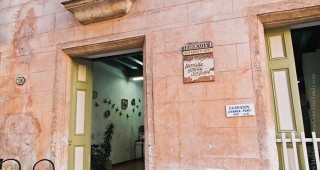
Santa María is the most popular beach among both Habaneros and visitors. It has lodgings, restaurants, watersports hire, grocery stores and a pharmacy. As with the other beahes, it boasts soft, white sand.

Santa María is the most popular beach among both Habaneros and visitors. It has lodgings, restaurants, watersports hire, grocery stores and a pharmacy. As with the other beahes, it boasts soft, white sand.

 2
2This 1915 two-story building was made of reinforced concrete. Its façade was composed of elements of the Ionic order and stood out because of its semicircular portico and its beautiful wooden door, wh …
 EclecticAdmission: FreeCuba e/ Obispo y Obrapía, Habana Vieja
EclecticAdmission: FreeCuba e/ Obispo y Obrapía, Habana Vieja 
 2
2By 1790, this originally mangrove swampy area became Campo de Marte, a military practice range, which was expanded in 1793 thanks to a project by Belgian engineer Agustin Cramer. And after Bishop Espa …

 2
2Up until 1834 there were no prisons in Havana. Back then, prisoners were crammed together in a small area on the Palacio de Gobierno’s basement. With this in mind, Lieutenant General Miguel Tacón, Gov …

 2
2This cement park was built in 1967 to honor university students involved in Cuba’s independence struggles. The most notable element, located by the most important entrance, can be interpreted a fist, …

 2
2The compact yet extravagant Beaux Arts building on the northwest corner of Prado and Trocadero was once the residence of Cuba’s second president, José Miguel Gómez, known as ‘El Tiburón’ (The Shark). …
 EclecticAdmission: FreePrado #212 esq. a Trocadero, Habana Vieja
EclecticAdmission: FreePrado #212 esq. a Trocadero, Habana Vieja 
 2
2This townhouse was adapted in 1898 into a pharmacy by Francisco Taquechel. Restored and reopened in 1996, it functions as pharmacy and museum. Its collection includes 19th-century French porcelain apo …

 1
1Constructed on piles–a solution that is essentially in the style of Le Corbusier, which apart from transmitting a sort of lightness to the building, makes the corner lose its traditional compactness; …
 Modern23 y 26
Modern23 y 26 
 1
1An interesting and typical example of the Streamline movement which preferred rounded corners and a sensation of motion can be seen in this building built in 1944. The recovery of simple forms and the …
 Art DecoSoledad esquina a San Lázaro
Art DecoSoledad esquina a San Lázaro 
 1
1The building of the railway station, expression of the Spanish plateresque style, was built in 1912 on the site of the former Armory. It has four floors with 77 windows and the main entrance is rounde …
 EclecticAdmission: FreeEgido esq. a Arsenal, Habana Vieja
EclecticAdmission: FreeEgido esq. a Arsenal, Habana Vieja 
 1
1This is the studio-gallery of ceramicists Amelia Carballo and Ángel Norniella. Their work shows a wide variety of influences and techniques, including the millenary raku, and as the name suggests focu …